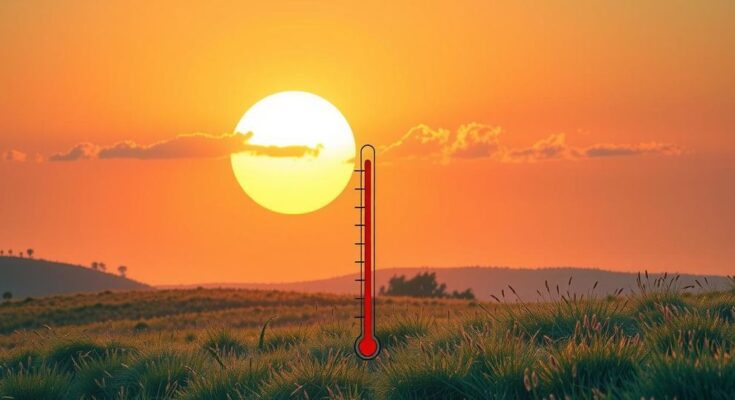January 2025 is likely the warmest January on record, with a 1.75°C anomaly above pre-industrial levels despite La Niña conditions. Record temperatures were observed globally, contradicting typical patterns associated with La Niña. The role of greenhouse gas emissions is noted as increasingly influential, overshadowing natural climatic cycles. Climate scientists express concern about potential warmer temperatures throughout the year, calling for urgent climate action.
January 2025 has emerged as potentially the warmest January on record, registering an average temperature anomaly of 1.75°C above the pre-industrial baseline (1850-1900), as reported by climate scientists analyzing the ERA5 dataset. This unprecedented anomaly is corroborated by higher-than-normal temperatures worldwide, affecting both hemispheres and disrupting usual seasonal patterns.
Notably, temperature records were shattered in Jamaica and Madagascar on January 31, affirming the unusual warmth of the month, as documented by weather historian M Herrera on social media. The ERA5 dataset is produced by the European Centre for Medium Range Weather Forecasting (ECMWF) as part of the Copernicus Climate Change Service (C3S) for the European Commission, providing critical climate data.
Remarkably, this record warmth occurred despite the presence of the La Niña phenomenon in the equatorial Pacific, typically associated with cooler global temperatures. This marks the first January with such warmth amid La Niña or neutral conditions, setting it apart from previous El Niño years.
According to climate scientist Zeke Hausfather, “January 2025 was quite unexpectedly the warmest January on record at 1.75°C above preindustrial, beating the prior record set in 2024.” This anomaly stands out as it has occurred despite La Niña conditions in the Pacific, following the El Niño event of 2023/2024.
Historically, previous record January temperatures were linked with ongoing El Niño conditions, such as in 2024 and 2016, or approaching El Niño circumstances like in 2020. El Niño represents the warmer phase of the El Niño Southern Oscillation (ENSO), which typically leads to increased global temperatures.
The World Meteorological Organization (WMO) declared the last El Niño phenomenon from July 2023 until its end in June 2024, contributing to 2024 being the warmest year recorded, with a temperature anomaly of 1.55°C higher than pre-industrial averages. La Niña conditions were last noted beginning in December 2024 and are expected to persist through early 2025.
The NOAA predicts this La Niña episode may be short-lived, unlike the prolonged La Niña from 2020 to 2023, which still coincided with extreme heat. In December 2024, the WMO cautioned that greenhouse gas emissions could continue fueling warming trends into 2025, overshadowing traditional climatic cycles like ENSO.
Despite expectations of a cooler 2025 due to La Niña, January’s temperatures indicate a contrary trend. “Both 2023 and 2024 were exceptionally warm years,” Hausfather noted, emphasizing the drivers behind this warmth.
In a striking deviation, January 2025 stands as an outlier amidst La Niña conditions, prompting speculation about the potential for higher annual temperatures than anticipated. As Hausfather remarks, an unexpected record in January could foreshadow warmer conditions for the year ahead.
The ongoing climate crisis continues to manifest through extreme temperature anomalies and changing weather patterns. These deviations from historical averages are investigated using datasets such as ERA5, which measures climate variables. The role of phenomena like El Niño and La Niña is crucial in understanding global temperatures, where prevailing conditions can dictate expected climatic behavior. However, greenhouse gas emissions have increasingly dominated these natural cycles, causing unprecedented climatic shifts and temperature records.
January 2025 has established itself as the warmest January on record, evidencing a significant temperature anomaly despite existing La Niña conditions. This unexpected outcome highlights the increasing impact of climate change, with greenhouse gas emissions overpowering natural climatic cycles. As we move forward, it appears data suggest that this anomaly could lead to higher annual temperatures than previously anticipated, emphasizing the urgent need for comprehensive climate action.
Original Source: www.downtoearth.org.in




